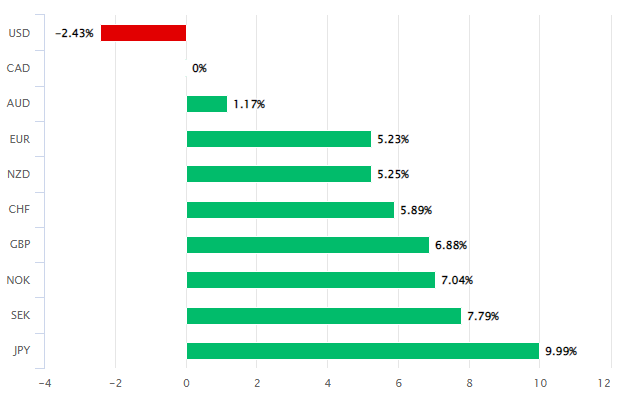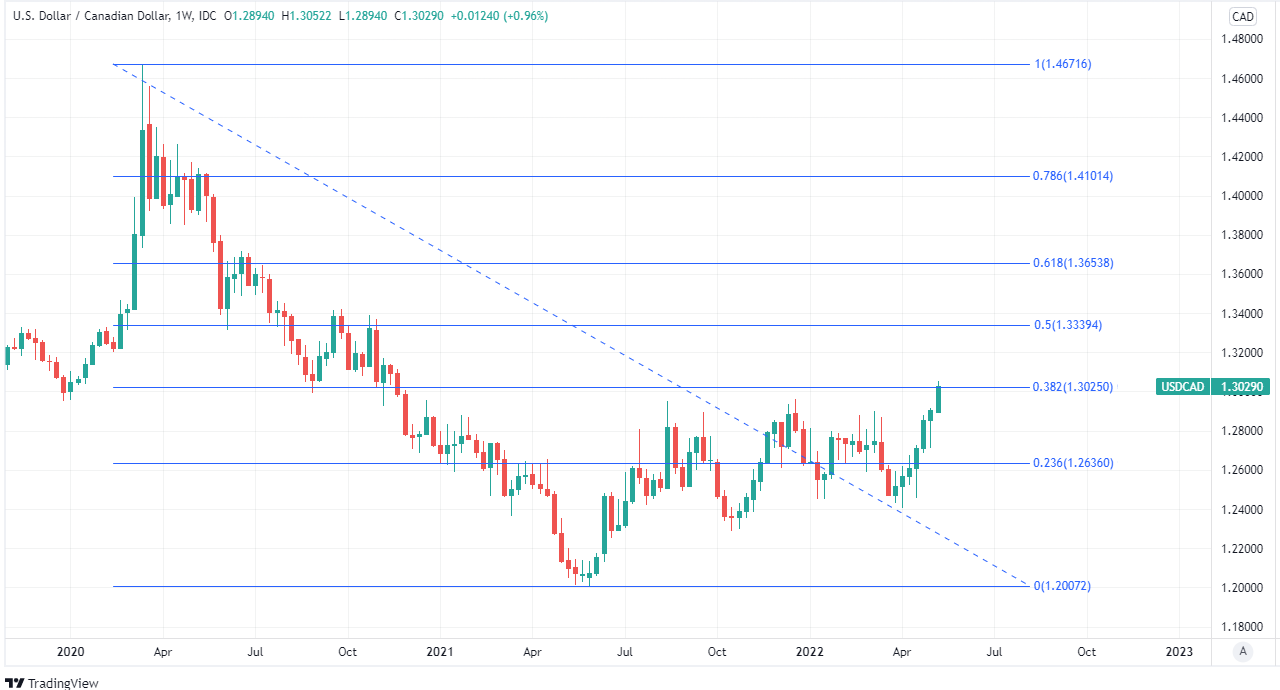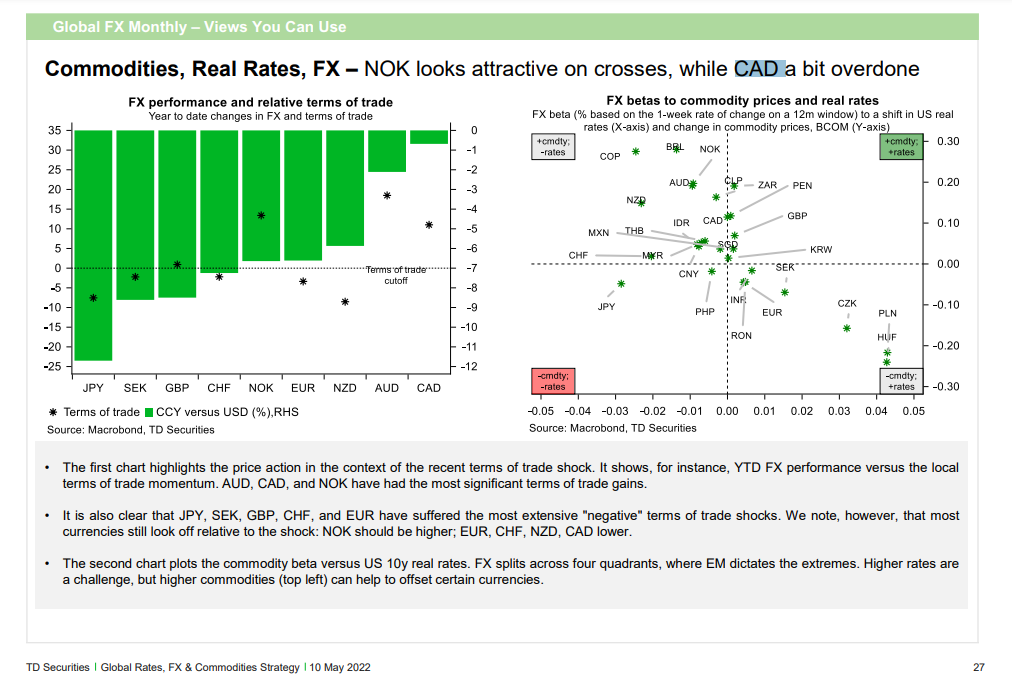Canadian Dollar Risks Are Still On the Downside, CIBC and TD Securities Say
- Written by: James Skinner
-
- USD/CAD risk still tilted higher, TD & CIBC say
- Break of 1.30 seen as likely for months ahead
- CIBC eyeing climb to 1.33 as TD warns of 1.35
- Global economy risks, BoC policy outlook cited

Image © Adobe Stock
The Canadian Dollar has remained an outperformer thus far in 2022 but its elevation and the factors underlying it are also the green shooting roots of an eventual downfall, according to CIBC Capital Markets, while TD Securities says that upside risks are dominant for USD/CAD in the short-term.
Canada’s Dollar topped the rankings of currencies within the G10 contingent through much of 2021 before entering the new year in second place behind the U.S. Dollar, a position it has managed to retain thus far in 2022.
This is a trend of North American outperformance that is echoed when the currencies under consideration are extended to include those within the broader G20 grouping where the Mexican Peso is also near the top of the rankings.
“Monetary policy in both the US and Canada have been largely consistent. Both the Fed and BoC now seem bent on getting the benchmark policy rates back to neutral in order to curb generational levels of inflation,” says Bipan Rai, North American head of FX strategy at CIBC Capital Markets.
“Both countries have benefitted from loose fiscal policy from prior years. While we do expect to see some drag later this year, the effect on growth from prior years stands in contrast to other countries,” Rai and colleagues said in a Tuesday research briefing.

Above: Canadian Dollar’s 2022 performance relative to G10 counterparts. Source: Pound Sterling Live.
CIBC says the Canadian Dollar’s outperformance is largely a reflection of the market’s broadly similar outlooks for Federal Reserve (Fed) and Bank of Canada (BoC) interest rates, which are expected to rise from 1% currently to a little more than 3% over the next year or so.
That is in turn the result of comparatively robust economies that have benefited from large doses of government spending to a greater extent than those in other regions since the onset of the coronavirus pandemic, although CIBC says the tables could turn quickly for Canada’s economy and Dollar.
“The market is expecting both central banks to finish this rate hike cycle at around 325bps. However, we don’t see this as a realistic conclusion to this cycle considering the difference in private sector leverage in both economies,” Rai and colleagues said on Tuesday.
“Given that Canadian households didn’t deleverage to the same degree that US households did after the global financial crisis, a rate hike north of the border will be “worth more” in terms of slowing real activity. As such, we feel the market is mispricing the BoC relative to the Fed,” they added.
Rai and the CIBC team say this “mispricing” of the outlook for Bank of Canada interest rates should eventually lead the USD/CAD pair to climb above 1.30 and toward the 1.33 level in the months ahead.
 Above: USD/CAD shown at weekly intervals with Fibonacci retracements of 2020 fall indicating possible medium-term areas of technical resistance for U.S. Dollar and support for the Canadian Dollar. Click image for closer inspection.
Above: USD/CAD shown at weekly intervals with Fibonacci retracements of 2020 fall indicating possible medium-term areas of technical resistance for U.S. Dollar and support for the Canadian Dollar. Click image for closer inspection.
CIBC has also warned, however, that any intervening fall back below the 1.27 level would be an indication of the above scenario being unlikely.
"If the equity panic reasserts itself over the next couple of weeks, then we could see USDCAD making another push through 1.3050 and potentially 1.3150. And if the S&P 500 were to drop to -25% YTD, we wouldn't entirely rule out a move in USDCAD to 1.3350 as Canadian pension managers trim their short-USDCAD hedges due to having less assets to hedge. However, we would point out that this move in USDCAD is already quite extended at levels above 1.28," says Greg Anderson, global head of FX strategy at BMO Capital Markets.
Meanwhile, TD Securities has cited rising corporate financing costs and recent crushing losses for stock markets as being among a series of foreboding indications about the global economic outlook.
This would in turn have adverse implications for commodity-linked currencies in the near future including the Canadian Dollar
“The fear of stagflation is mounting and that's an environment that could be short-term problematic for the commodity intensive currencies that require stable global growth to maintain their loftiness,” says Mark McCormick, global head of FX strategy at TD Securities.
“These currencies stand to underperform further against the EUR and JPY where their [terms of trade] gains have been most acute,” McCormick and colleagues wrote in a Tuesday market commentary before warning that “We think investors should be mindful of a USDCAD return to 1.35.”
 Source: TD Securities. Click image for closer inspection.
Source: TD Securities. Click image for closer inspection.











